Exam 1: Evidence Based Medicine, Health Behavior Theories/Prevention/Epi
1/50
There's no tags or description
Looks like no tags are added yet.
Name | Mastery | Learn | Test | Matching | Spaced |
|---|
No study sessions yet.
51 Terms
The World Health Organization defines health as a...
"a state of complete physical, mental and social well-being and not merely the absence of disease or infirmity."
Wellness is the act of....
practicing healthy habits on a daily basis to attain better physical & mental health outcomes, so that instead of surviving, you're thriving
Evidence-based medicine (EBM)
the conscientious, explicit and judicious use of current best evidence, combined with individual clinical expertise and patient preferences and values, in making decisions about the care of individual patients
- “the integration of best research evidence with clinical expertise and patient values.”
Traditional Model of EBM: 3 components
- clinical expertise
- evidence
- patient preferences
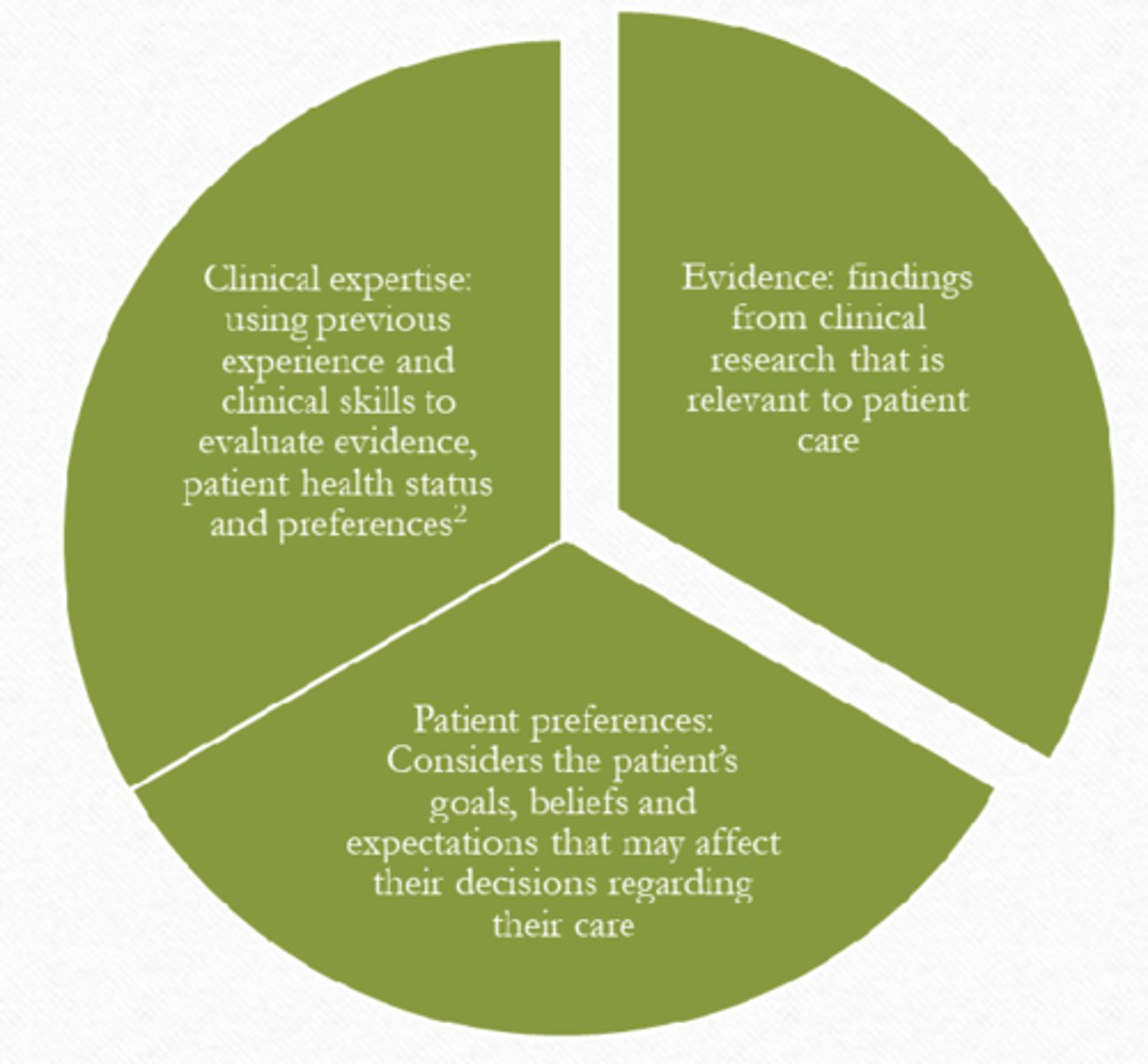
Newer Model of EBM: 4 components
- clinical expertise
- evidence
- patient preferences
- clinical circumstances
Includes clinical state and circumstances separated from clinical expertise
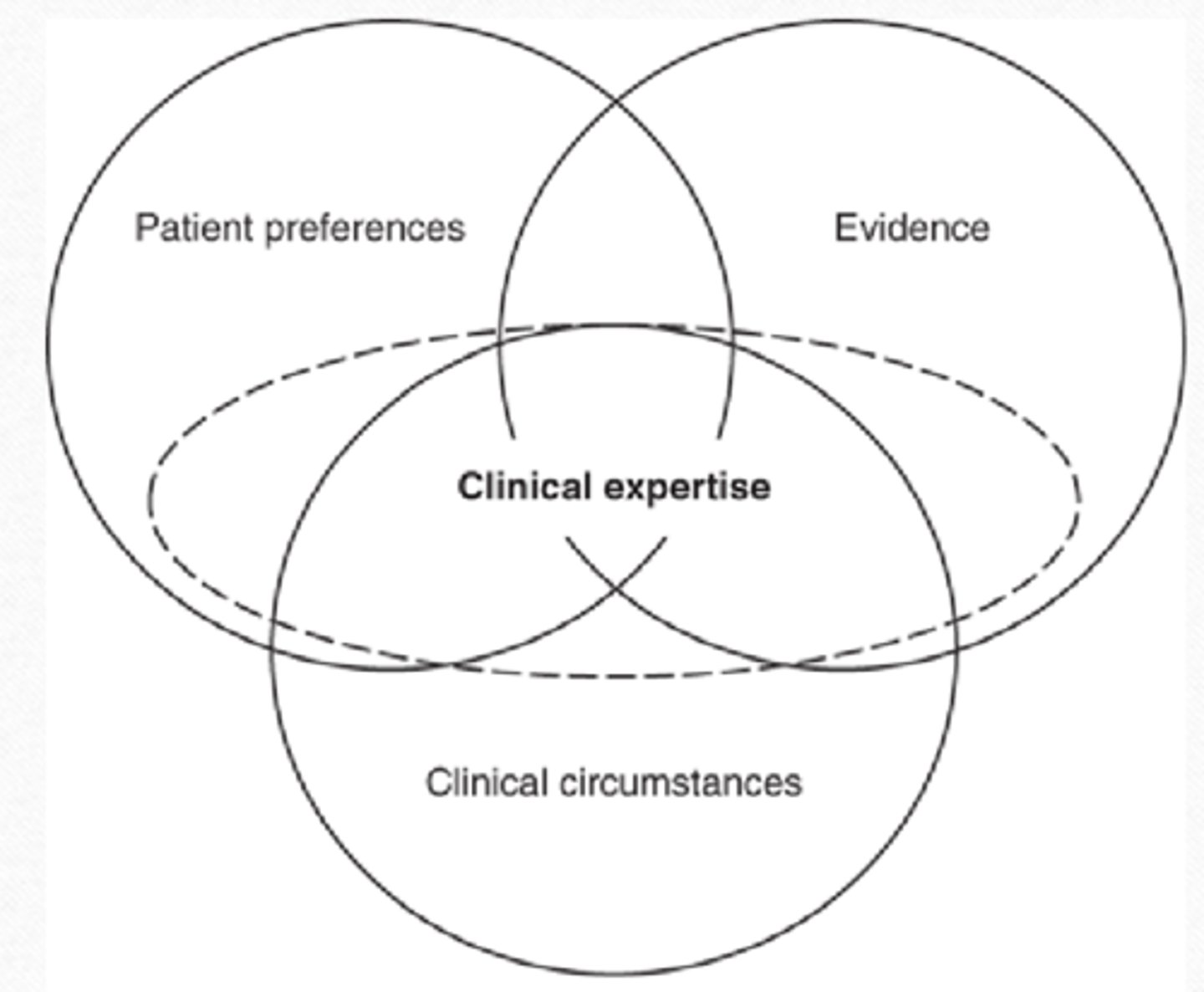
Clinical state
reason for the intervention
Clinical circumstance
setting (primary, secondary, tertiary) where care is provided
Steps in the EBM Process (4)
- Construct
- Perform
- Evaluate
- Apply
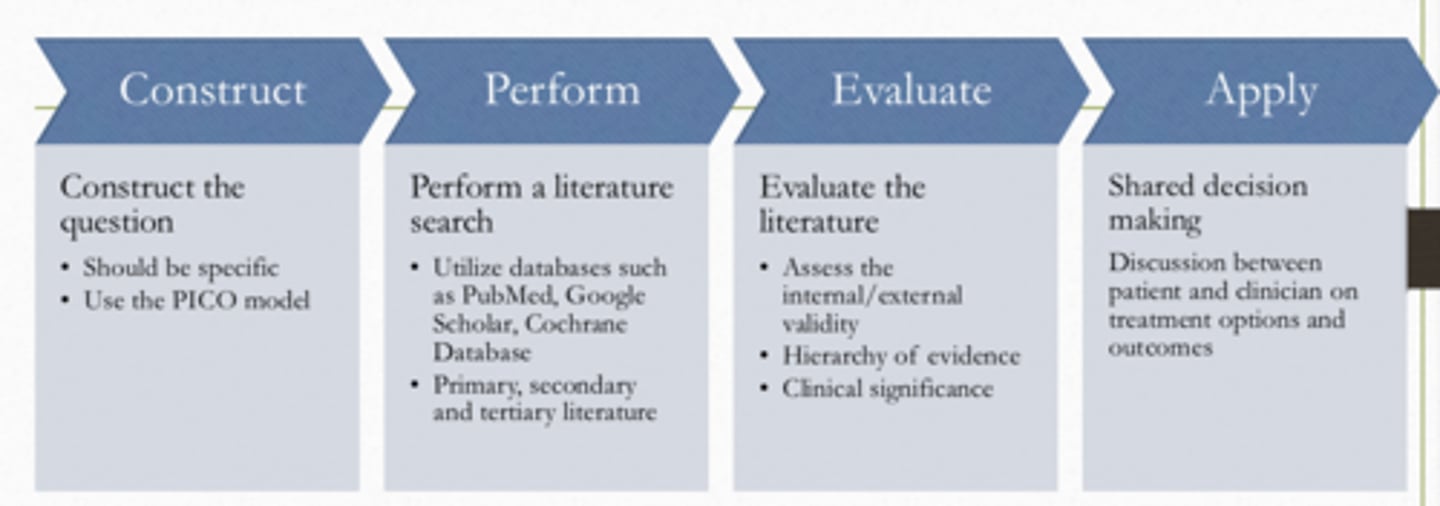
Step 1: Formulating a Question
Without formulating a good question, answers will be too broad and overwhelming
- PICOT

Formulating a Question: What is PICOT?
P: population, patient
I: Intervention
C: comparison
O: outcome
T: timeframe
ex: In adult patients with diabetes (Population), what is the effect of lisinopril (Intervention) on blood pressure (Outcome) compared with enalapril(Comparison)?

Step 2: Performing a Literature Search
Types of literature
- Primary
- Secondary
- Tertiary

Types of literature: Primary (5)
- usually includes hypothesis, methodology, & results
- original research
- randomized clinical trials
- case studies
- cohort studies

Types of literature: Secondary (6)
- summaries & comparisons of primary literature
- systematic reviews
- meta analysis
- literature reviews
- drug databases
- clinical practice guidelines

Types of literature: Tertiary (3)
- compilations of information on a topic
- textbooks
- encyclopedia

Databases (8)
- PubMed
- Cochrane Library
- Embase
- Medline
- Google Scholar
- ProQuest Dissertations and Theses
- DynaMed
- Lexicomp
Step 3: Evaluatethe Literature
- Hierarchy of evidence (expert opinion< case series/reports< case-control studies< cohort studies< randomized controlled trials< systematic reviews/metal-analysis
- Considerations: (are the results valid? are the results clinically significant? do the results apply to my patient?)
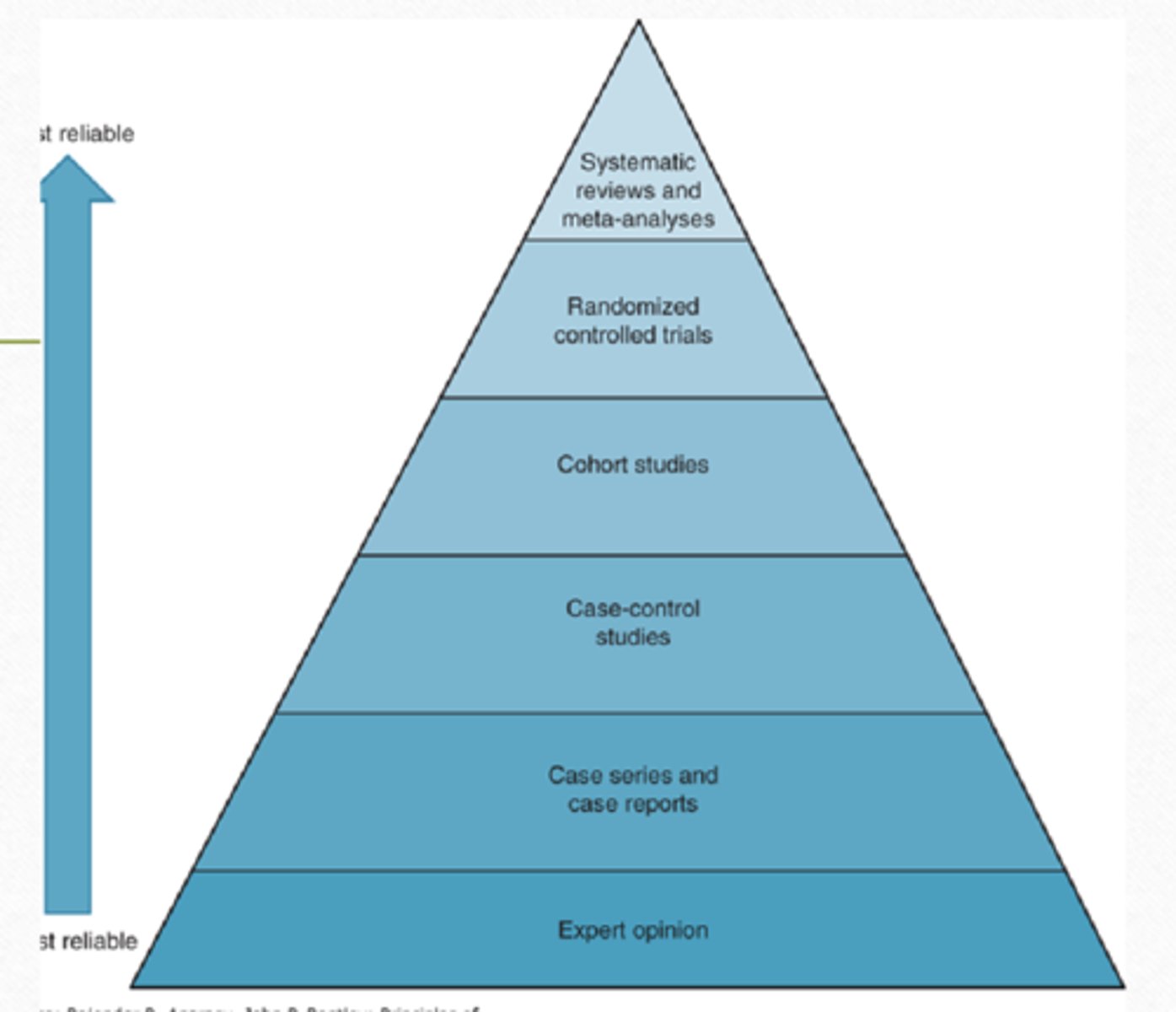
Systematic review
collecting and summarizing all evidence that fits pre-specified criteria
Meta-analysis
statistical methods to summarize the results of all the studies gathered
Randomized controlled trials
- Prospective studies that measure the effectiveness of a new intervention or treatment
- Examine cause-effect relationships between an intervention and outcome
Cohort studies
- a longitudinal, observational study that follows patients over a certain period (years) who share common defined characteristics (ex: demographics or occupation)
- some of the cohort will be exposed to a specific variable or characteristic
- outcomes are then measured over time to explore the impact of the exposure or event of interest
- good for epidemiology, helps to understand what risk factors may cause certain diseases (Framingham study)
Case-Control studies
- are retrospective
- population is identified by the outcome
- controls are then identified in the same population (w/o the outcome) to assess exposure to risk factors
- examines multiple exposures and risk factors (smoking and lung cancer)
Case reports
Describes one individual or event and the intervention used
Step 4: Apply
- Incorporate the evidence into the shared decision-making process (includes taking the patient's goals, desires/values into consideration, will influence the outcome)
- by discussing the different options and expected outcomes, the patient and healthcare provider can agree on what treatment is best
What are Clinical Practice Guidelines
systematically developed statements that intend to assist clinicians and patients in making decisions about appropriate health care in specific circumstances
What do CPGs aim to improve? By doing what?
- the quality of patient care by encouraging interventions of proven benefit and discouraging the use of ineffective/harmful interventions
- reduce unnecessary variation in practice
- lessens dispartities
- empowers patients
- influence public policy
Tips to keep in mind when using guidelines (3)
- make sure it is the most current guideline available
- evaluate the accuracy
- make sure it is the correct guidline
What do CPGs consist of? (6)
- Introduction
- Methodology & evidence review
- committee members
- COI disclosures
- conclusion
- information on disease state (diagnosis, classification, risk factors, comorbidities, nonpharmacologic interventions, pharmacologic interventions)
Strength of Evidence and Recommendations
- Class I (strong): Benefit >>> risk (is recommended, is useful, should be administered)
- Class IIa (moderate): Benefit >> risk (is reasonable, can be useful)
- Class IIb (weak): Benefit > risk (may/might be reasonable, usefulness unkown)
- Class III: no benefit (moderate): Benefit = risk (is not recommended, not useful, should not be administered)
- Class III: Harm (strong): Risk > benefit (potentially harmful, causes harm, excess morbidity/mortality)
- Level A: high-quality evidence, more than 1 RCT, meta-analysis of RCTs
- Level B-R (randomized): moderate quality evidence from more than 1 RCT, meta-analysis of moderate RCT
- Level B-NR (nonrandomized): moderate quality evidence from 1 or more well-designed, nonrandomized studies observational studies, registry
- Level C-LD (limited data): randomized or non-randomized observational or registry study
- Level C-EO (expert opinion): consensus of expert opinion based on clinical expertise
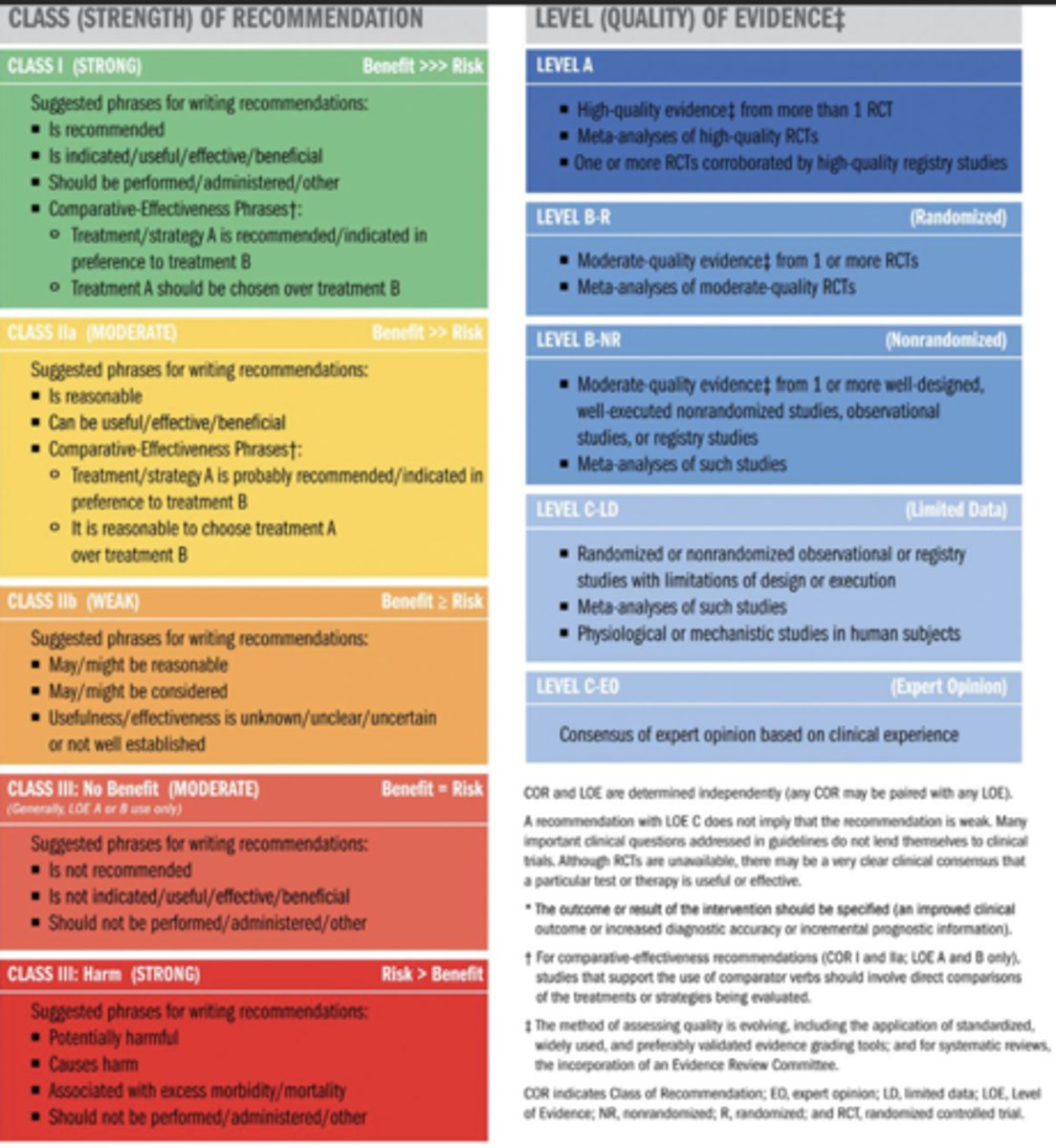
1. What is the class of recommendation?
2. What is the level of evidence?
1. Class I, level A; Class I, level C-EO; Class I, level C-LD
2. A: high quality evidence from more than 1 RCT
C-EO: expert opinion
C-LD: limited data

What is a clinical practice algorithm?
flow chart that represents stepwise procedures for clinical decision making and management of a clinical problem
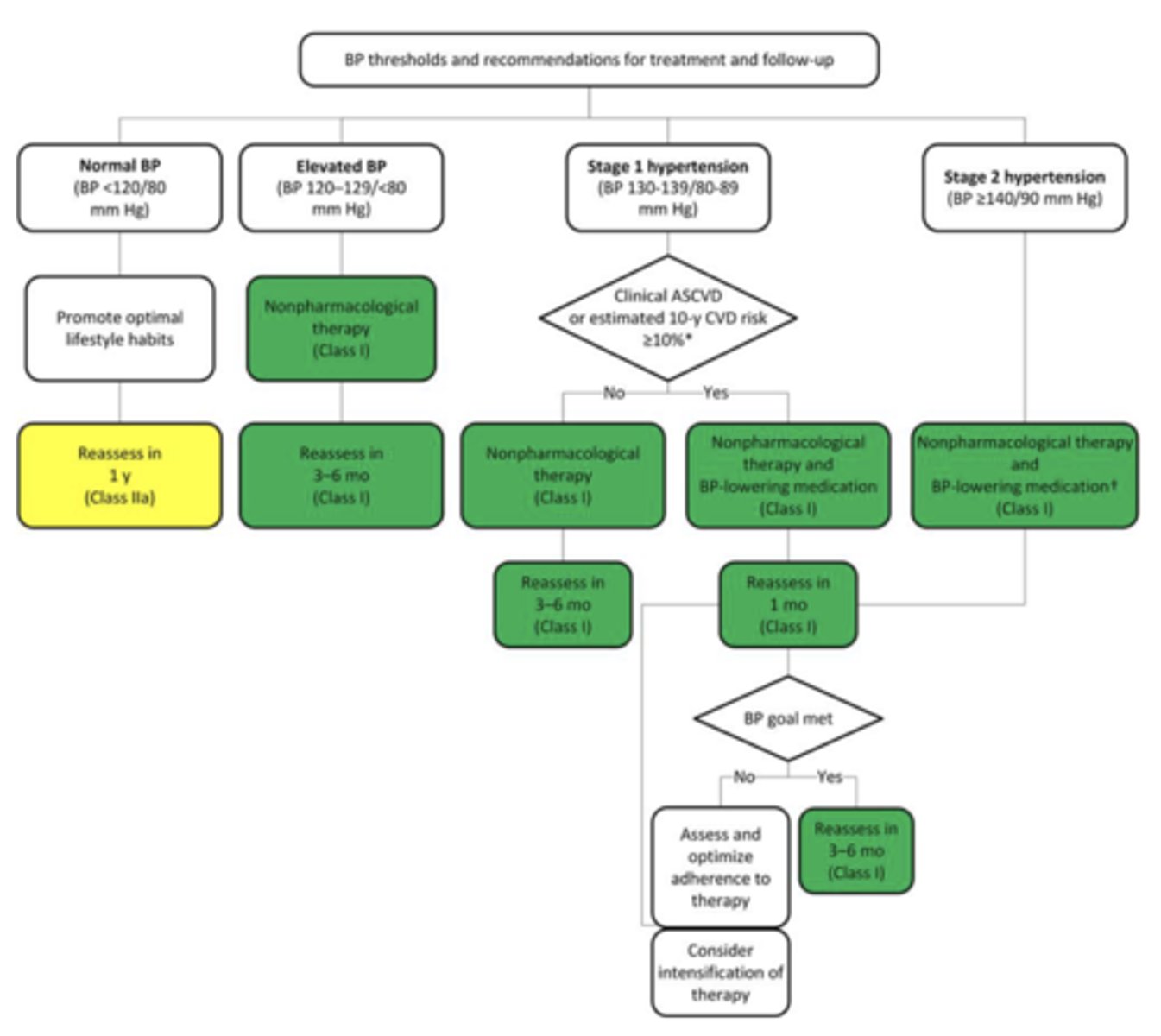
Where can guidelines be found? (5)
1. Lexicomp
2. DynaMed
3. PubMed
4. Google
5. ECRI Guidelines Trust
What are advantages of CPGs? (From article) (3)
- Based on systemic review
- considers patient subgroups and preferences
- have a clear process that minimizes biases, conflicts of interest, and distortions
What are disadvantages of CPGs? (from article) (4)
- Only focus on one disease state
- outdate quickly
- different CPG's may have different recommendations for same disease state
- many do not include patient values and preferences
What is GRADE?
Set of guidelines that help CPG authors rate quality of evidence that they put into their own CPG's, from very low, low, moderate, and high
- to give healthcare professionals who use their CPGS's as an indication of how confident they are that the evidence being provided to them is accurate
- Allows for CPG's authors to inform healthcare professionals whether or not the treatment is the best option, or if its not the right route
The Health Belief Model was developed by....
HOCHBAUM in the 1950s
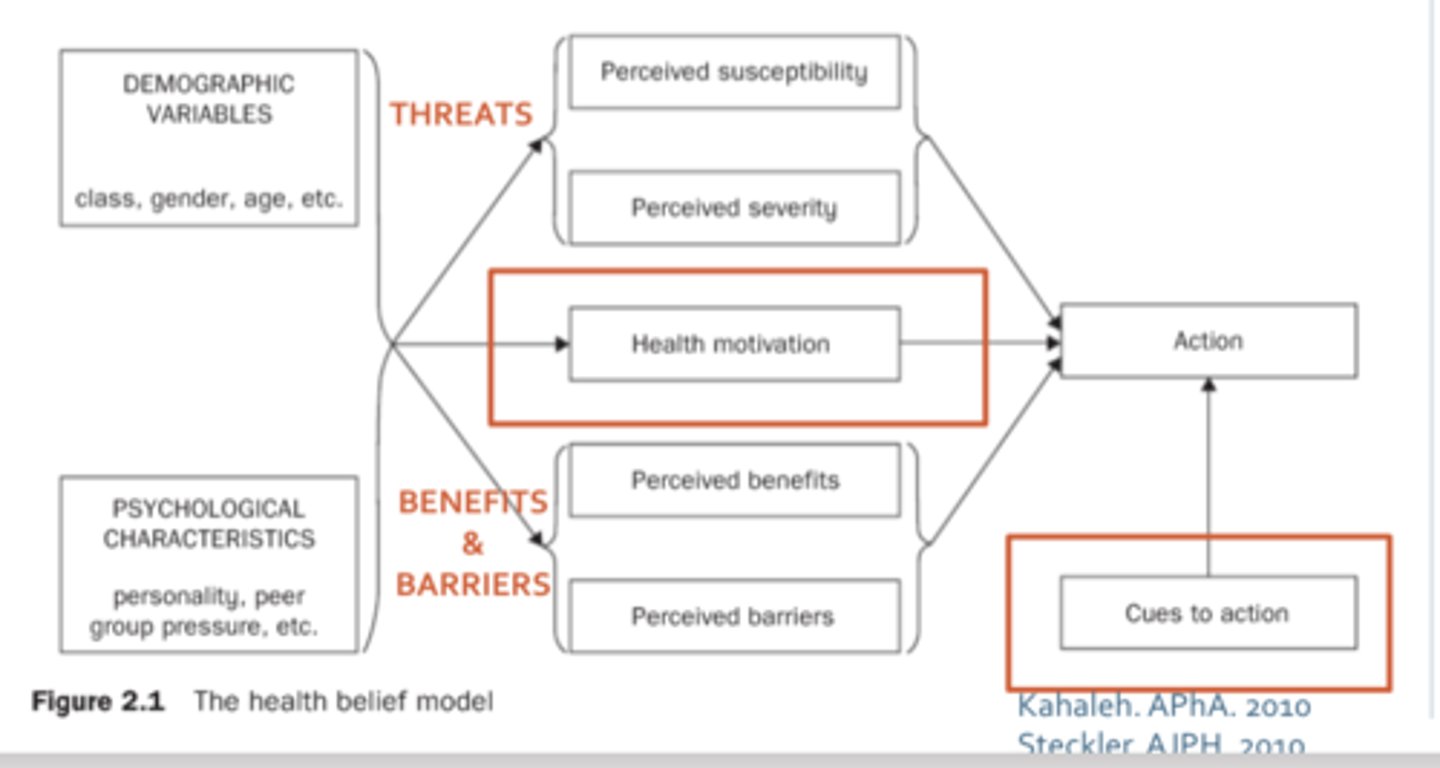
What dod the health belief model evaluate?
what motivated people to get tuberculosis X-ray screening
(What factors most influence our “likelihood” to act or change behaviors?)
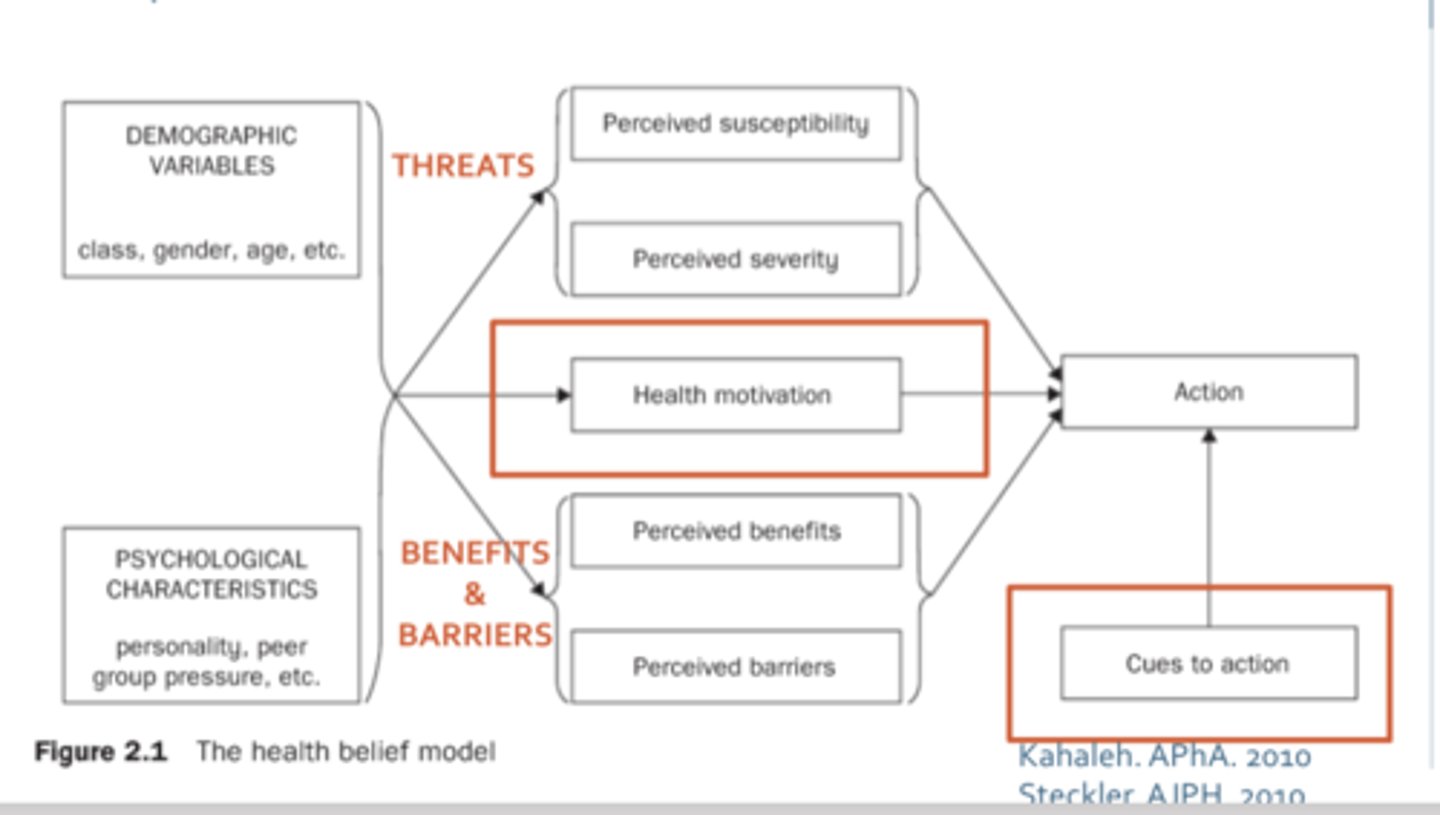
Health Belief Model (another look chart)
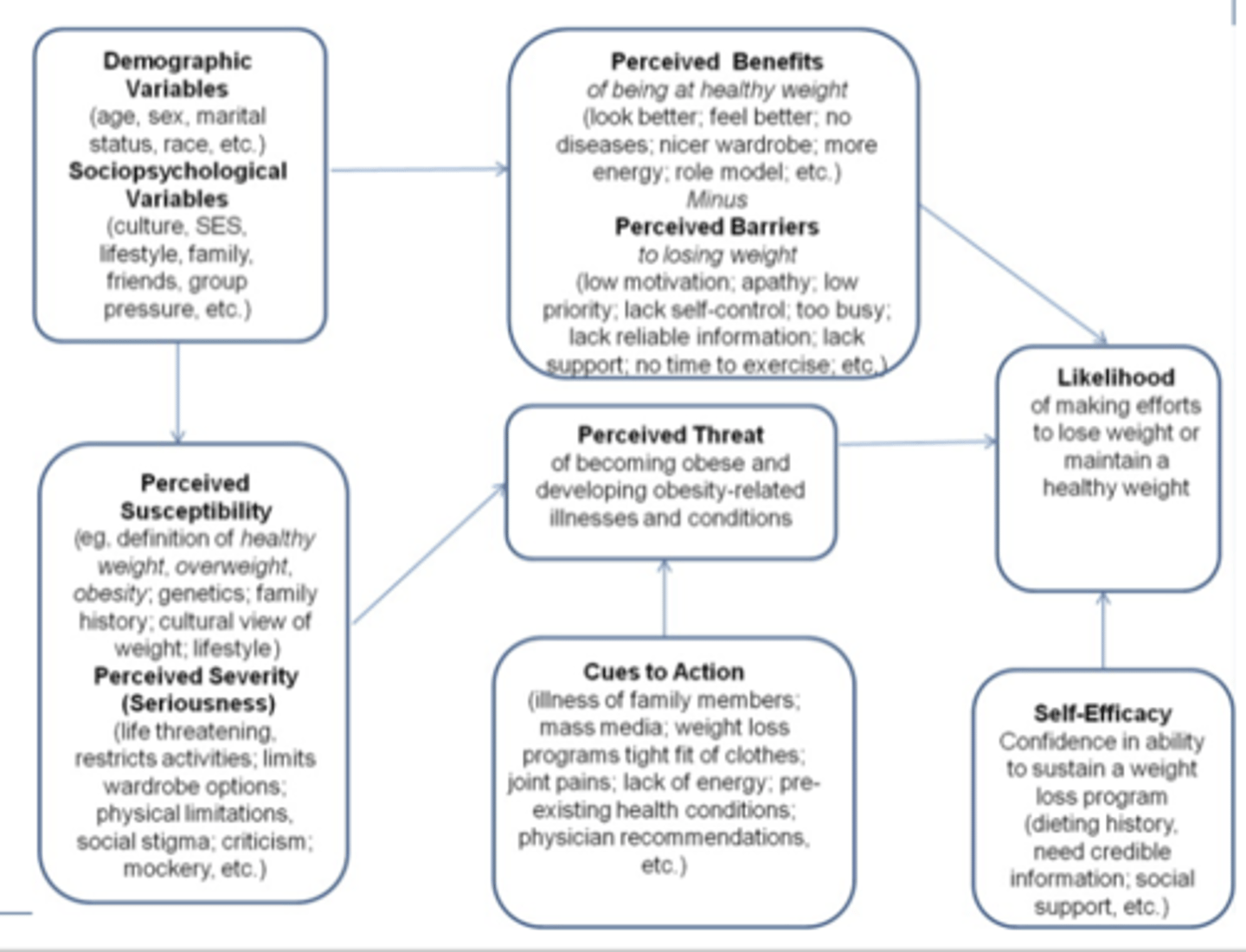
Health belief model examples of:
- Perceived susceptibility
- Perceived severity/seriousness
- Perceived benefits
- Perceived barriers
- Cues to action
- Self-efficacy
- Susceptibility: "I don't ever get the flu. I don't need a vaccine"
- Severity/Seriousness: "If I get the flu, I'm young and will just get over it"
- Benefit: "I think getting the vaccine is better than getting the flu"
- Barriers: "It is too far to drive to get a flu vaccine"
- Cues to action: public service announcement on radio, free flu vaccine prompted by employer
- Self-efficacy: Seeking information about the benefits of the flu vaccine
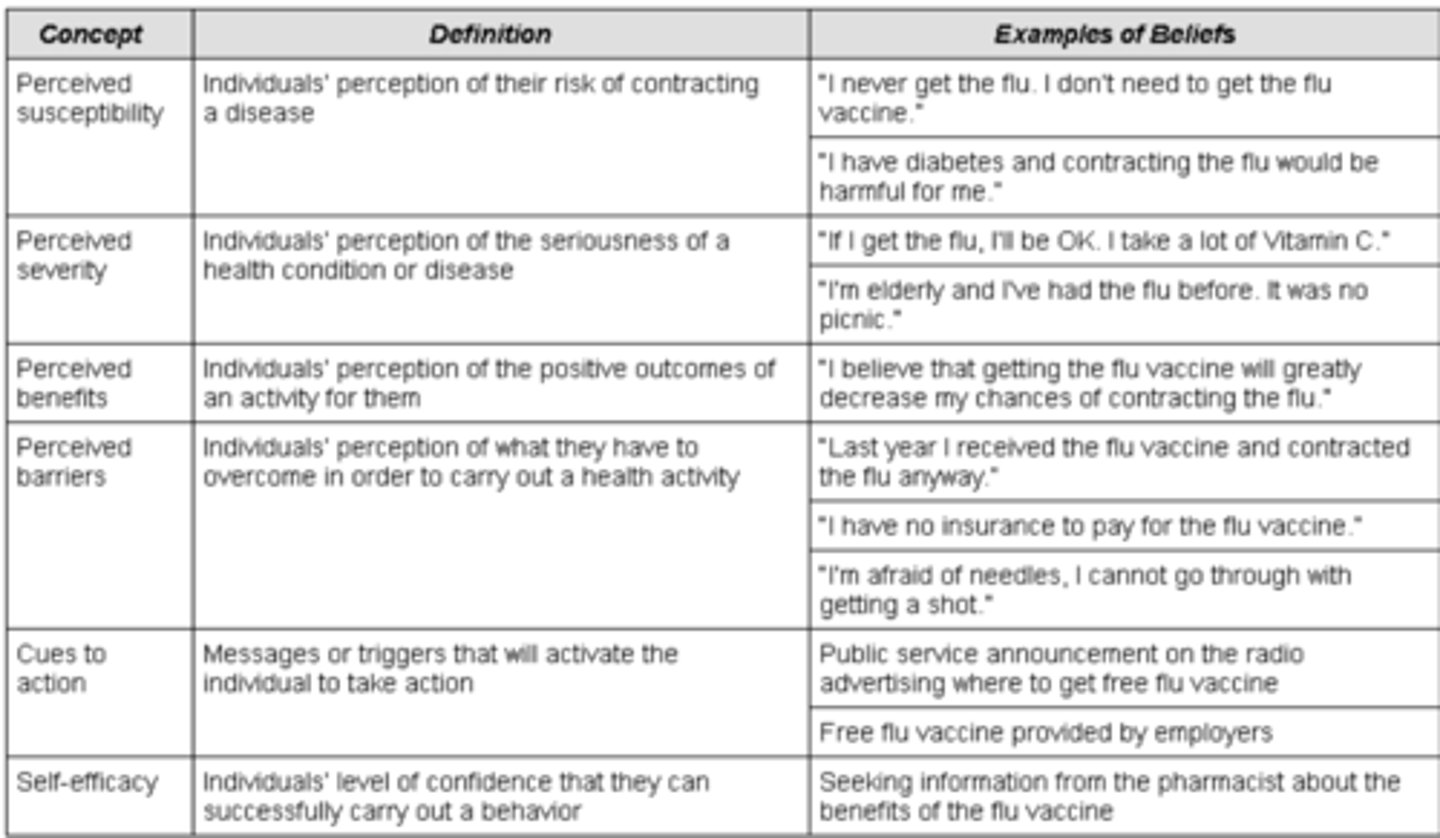
Transtheoretical Model (Stages of change)
- by prochaska & DiClemente- developed in smoking cessation
- helped to assess "readiness for change" and confidence to make a new change
- Evaluated readiness to make a change in behaviors
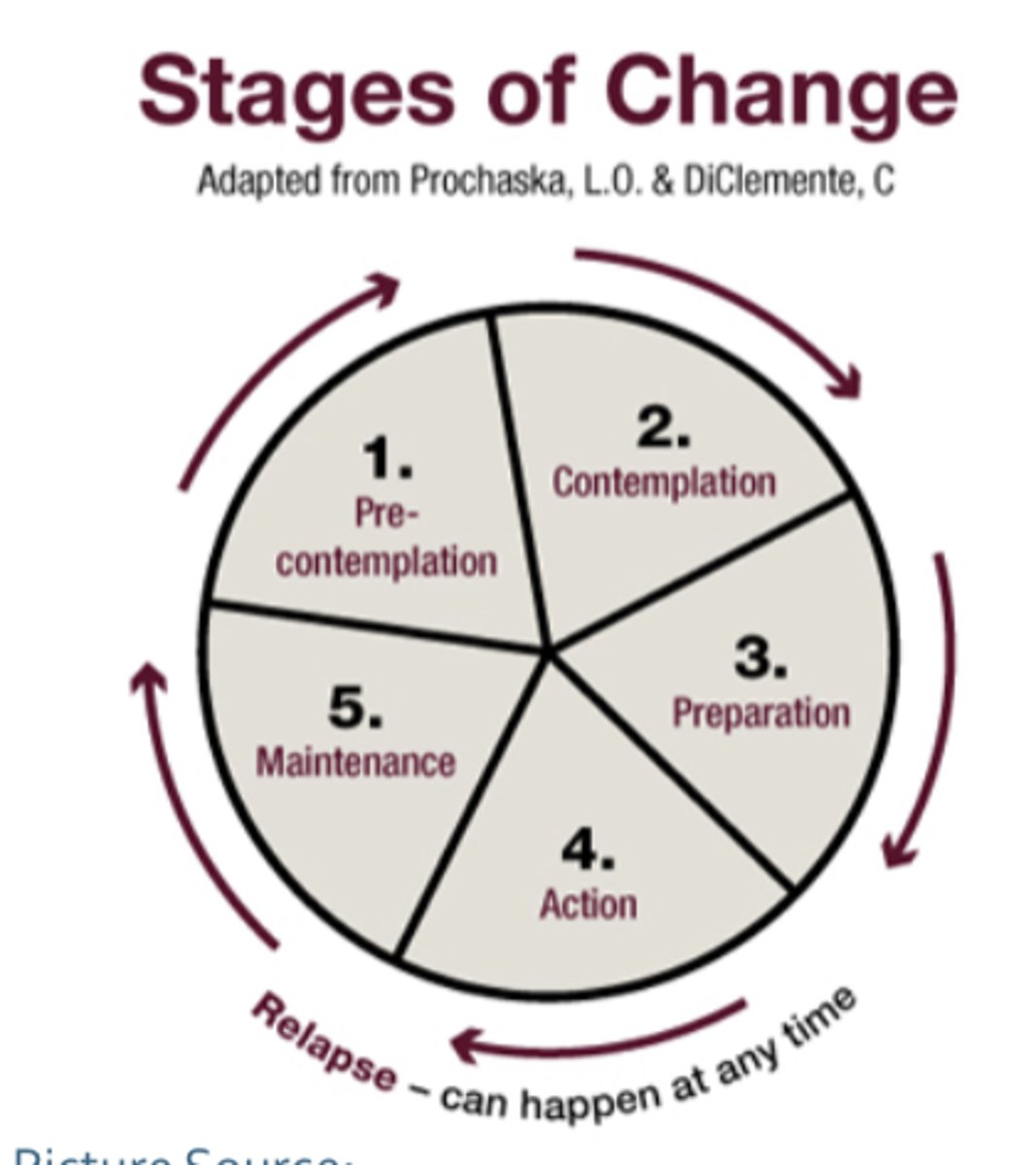
What are the stages of change in the Transtheoretical Model? (4)
1. Pre-contemplation (no intention of taking action in next 6 months)
2. Contemplation (intends to take action in next 6 months)
3. Preparation (intends to take action within next 30 days)
4. Action (has changed behavior for less than 6 months)
5. Maintenance (has changed behavior for more than 6 months)
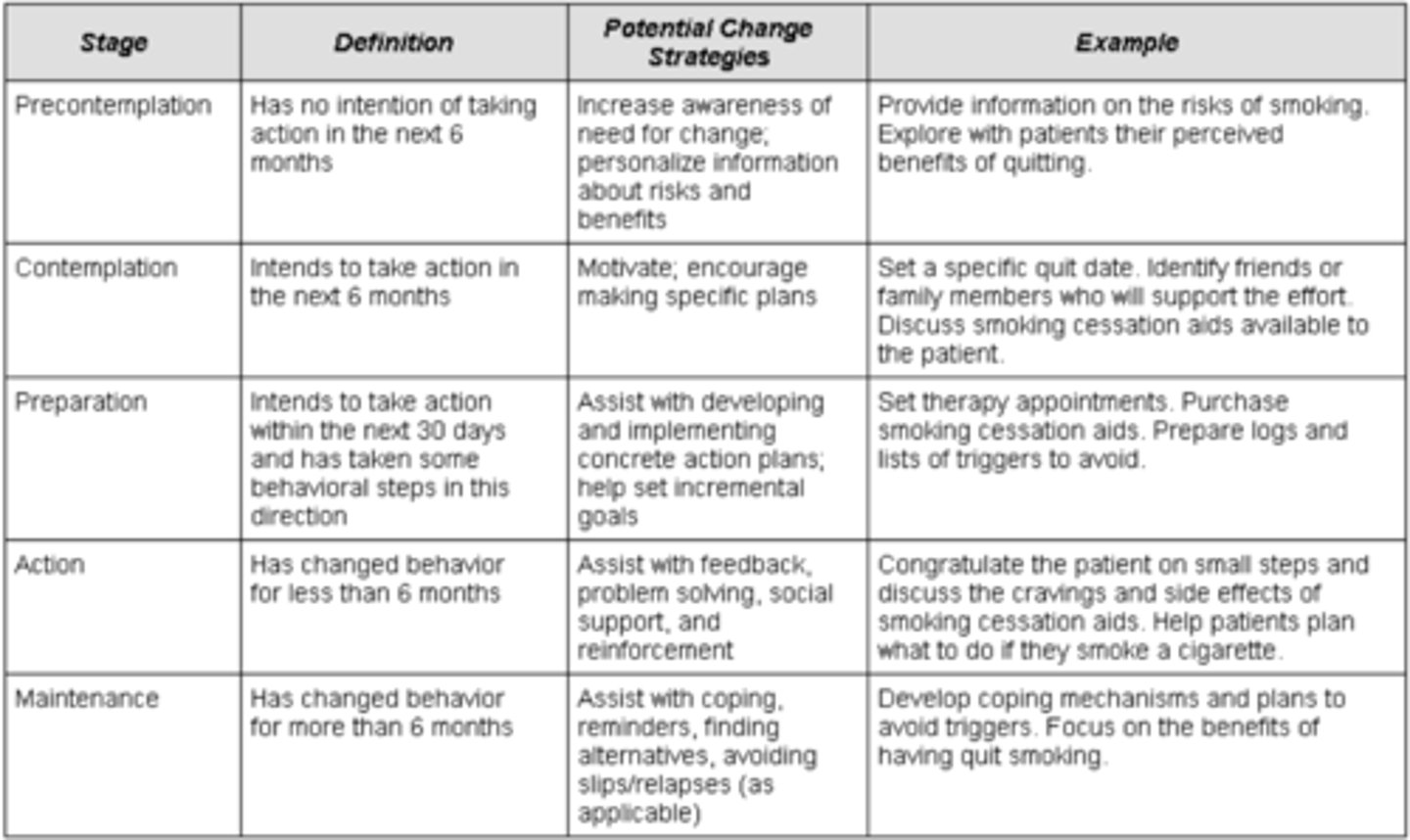
Transtheoretical Model exmples
1. Pre-contemplation
2. Contemplation
3. Preparation
4. Action
5. Maintenance
1. Pre-contemplation: "I know the risks of smoking, but I don't want to quit, I enjoy it too much"
2. Contemplation: "Maybe I should consider quitting. The doctor said I have a chance of heart attack"
3. Preparation: "I want to quit in a couple of weeks and will go to my appointments"
4. Action: "I have quit for 3 weeks!"
5. Maintenance: "I can't believe I haven't smoked in 6 months, a baddie!"
Types of prevention (3)
Primary, Secondary, Tertiary
Examples of primary prevention (4)
prevent a disorder/disease from developing (new)
- vaccinations
- counseling to change high-risk behavior
- lifestyle
- sometimes may include medication
Examples of secondary prevention (2)
detect and/or treat a disease or disorder early (sometimes prior to symptoms developing)
- screening programs
- early treatment of chronic disease (may include meds)
Examples of tertiary prevention (2)
prevent further complications of a (often chronic) disease
- diabetic, preventing complications
- had a stroke, preventing second stroke/disability
Prevention model (chart)

Epidemiology
- "the method used to find the causes of health outcomes/diseases in populations"
- patient is the community & individuals are viewed collectively
- The study (scientific, systematic, and data-driven) of the distribution (frequency, pattern) and determinants (causes, risk factors) of health-related states and events(not just diseases) in specified populations (neighborhood, school, city, state, country, global) and the application of this study to the control of health problems.
Morbidity
not having a state of well-being (physiological or psychological)
(disease, injury, disability)
Mortality (rates)
# Deaths (frequency) during a specific time frame / avg size of population
Incidence (proportion)
DEVELOP the disease or condition in a time period
- # of NEW cases in a specific time period

Prevalence (period)
HAVE the disease or condition in a time period
- # of disease cases (new + already existing) in a specific timeframe
- common for chronic disease
